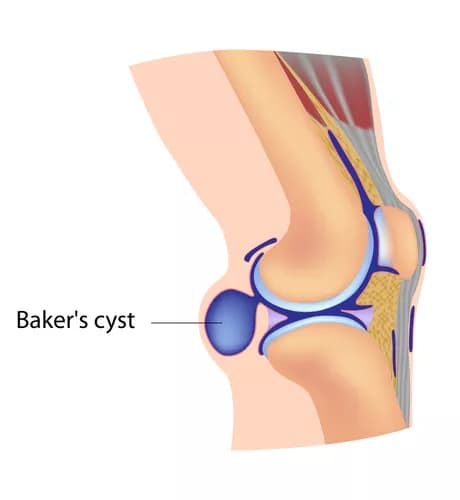What are the other Names for this Condition? (Also known as/Synonyms)
- Popliteal Cyst
What is Baker’s Cyst? (Definition/Background Information)
- A Baker's Cyst is a fluid-filled cyst located on the back of the knee. The cyst forms due to an increased amount of synovial fluid that normally lubricates the knee joint
- A Baker's Cyst commonly occurs in middle-aged adults with underlying knee joint conditions such as arthritis of the knee joint or any tear in the joint cartilage
- The most common signs and symptoms of a Baker's Cyst are pain, swelling, stiffness in the back of knee, and worsening of the pain when the knee is fully extended, bent, or in action
- Usually Baker's Cyst is diagnosed based on signs, symptoms, appearance, feel of the cyst, and a recent medical history
- There are no serious complications associated with Baker's Cyst, and frequently the cyst disappears on its own. Pain-relieving medications (NSAIDs), icing, and rest may help to ease the symptoms
- If the symptoms are severe and do not get better with medication and rest, then a surgery may be performed to remove the Baker’s Cyst. Overall, the prognosis of Baker's Cyst is very good with appropriate treatment
Who gets Baker’s Cyst? (Age and Sex Distribution)
- A majority of adults with Baker's Cysts are over the age of 40 years, though this condition is observed in males and females of all ages
- However, females are more likely to get this condition than males
What are the Risk Factors for Baker’s Cyst? (Predisposing Factors)
- The most important risk factor for a Baker's Cyst is arthritis of the knee joint
It is important to note that having a risk factor does not mean that one will get the condition. A risk factor increases ones chances of getting a condition compared to an individual without the risk factors. Some risk factors are more important than others.
Also, not having a risk factor does not mean that an individual will not get the condition. It is always important to discuss the effect of risk factors with your healthcare provider.
What are the Causes of Baker’s Cyst? (Etiology)
The main causative factors for Baker's Cysts may include:
- Underlying knee conditions such as a cartilage tear
- Knee arthritis
- Rheumatoid arthritis
These conditions may cause excess buildup of synovial fluid in the back of the knee, (synovial fluid normally lubricates the knee joint). The excess fluid may irritate the popliteal bursae (fluid-filled sacs) located in the region.
What are the Signs and Symptoms of Baker’s Cyst?
Baker's Cyst may be described as a soft and minimally tender bulge on the back of the knee. The signs and symptoms of a Baker's Cyst may include:
- Pain, swelling, and stiffness in the back of the knee
- Sometimes, the condition may be asymptomatic; no signs or symptoms present
- Usually, the symptoms worsen after one is active or stands for a long period of time
- Symptoms also worsen when the leg is fully extended (straight) or fully flexed (bent)
- Knee joint may click, buckle, or lock
How is Baker’s Cyst Diagnosed?
A Baker's Cyst diagnosis may include the following:
- Complete evaluation of medical history (recent) along with a thorough physical examination of the knee joint. The feel and appearance of the cyst is also examined
- Imaging studies, such as a knee X-ray and CT scan, can present a detailed picture of the knee joint
Many clinical conditions may have similar signs and symptoms. Your healthcare provider may perform additional tests to rule out other clinical conditions to arrive at a definitive diagnosis.
What are the possible Complications of Baker’s Cyst?
- There are no serious complications associated with a Baker's Cyst
- Sometimes, the cyst may rupture and cause synovial fluid to leak into the calf muscle, causing additional pain and swelling in the lower leg
How is Baker’s Cyst Treated?
Often, a Baker's Cyst disappears on its own. Otherwise, several treatment methods are available:
- In minor cases, NSAID medication may be used to manage the pain and inflammation; in severe cases, steroids may be injected to reduce inflammation
- Fluid drainage may help remove the excess fluid from the joint (called as needle aspiration)
- Physical therapy may be employed that includes treating the cyst using ice, compression wraps, and the use of crutches, as well as range of motion exercises and strengthening exercises for muscles around the joint
- The physician may recommend surgery to repair a cartilage tear, if that is the underlying cause
- If the cyst recurs, despite repeated drainage, the physician may choose to remove the cyst through a surgical procedure
How can Baker’s Cyst be Prevented?
A Baker's Cyst commonly occurs in individuals with underlying knee conditions such as arthritis.
- There are no effective measures to prevent the occurrence of Baker's Cysts
- Taking measures to prevent arthritis can help prevent the formation of the cyst
What is the Prognosis of Baker’s Cyst? (Outcomes/Resolutions)
- A Baker’s Cyst will usually disappear on its own, or the symptoms may appear and subside, from time to time
- Nevertheless, there are no disabling or serious complications associated with it
- The prognosis of a Baker's Cyst is very good with suitable treatment
Additional and Relevant Useful Information for Baker’s Cyst:
A Baker’s Cyst removal surgical procedure is performed if the Baker’s Cyst begins to cause any discomfort or pain, and sometimes for cosmetic reasons.
The following article link will help you understand Baker’s Cyst removal surgical procedure:
https://www.dovemed.com/common-procedures/procedures-surgical/bakers-cyst-removal/
Related Articles
Test Your Knowledge
Asked by users
Related Centers
Related Specialties
Related Physicians
Related Procedures
Related Resources
Join DoveHubs
and connect with fellow professionals


0 Comments
Please log in to post a comment.